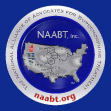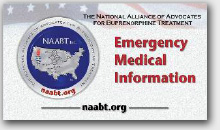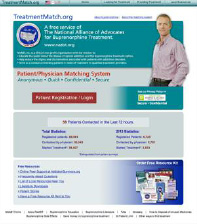FDA says “NO” to safer, longer-lasting form of buprenorphine that cannot be lost, stolen, sold or accidentally ingested by children.
Imagine a form of buprenorphine which could not be lost, stolen or sold; delivered a consistent daily dose (could not be overdosed or underdosed); ensured at least six months of medication compliance; had absolutely no risk of accidental pediatric exposure; and would still be effective at treating opioid addiction. Sounds like a miracle, or at least a major step forward, right? Not according to the FDA who earlier this year rejected such an advancement in treatment and for reasons largely unrelated to the medication’s lifesaving potential. Meanwhile, the CDC reports 45 people a day die from prescription opioid overdose.
In April, 2013, the FDA rejected Probuphine®, a new mode of administration of buprenorphine in the treatment of opioid addiction. Probuphine is a buprenorphine impregnated rod that is inserted just below the skin and provides a steady dose of buprenorphine for six months. On September 4, 2013, Titan Pharmaceuticals, the manufacturer, requested a meeting to review the decision with the FDA to urge them to reverse their decision. This medication would fill the needs of an underserved population who desperately need it; and we believe the FDA should reconsider.
The decision by the FDA to reject Probuphine was a surprise. Not only because it was inconsistent with the recommendation of their own appointed advisory committee which voted to approve it, but also because it was in contrast to epidemic warnings from the CDC; the stated policy of the ONDCP; diversion concerns of the DEA; industry safety trends; and statements from the FDA itself.
- The CDC characterized the prescription opioid overdose problems as an epidemic – killing 45 people a day (that’s more than suicides, US combat deaths, and even Chicago killings). More stunning is that the 45 people a day figure does NOT include heroin overdoses – it's prescription opioid medications only.
- The ONDCP is committed to expanding evidence-based treatments, prevent diversion and reduce accidental overdose deaths.
- The DEA is so concerned about diversion of buprenorphine film and tablets (a topic for another day) that they use their scarce resources to make unannounced inspections of certified physicians treating opioid addiction with buprenorphine, even though the DEA is not required to do so by law.
- The manufacturer of the popular Suboxone® Tablets recently took them off the market (in favor of their film version) citing mounting concerns of accidental pediatric exposure. They also tried to get the FDA to block any future tablet versions.
|
Background: Buprenorphine is the active ingredient in Suboxone and Subutex and their generic equivalents and considered to be the most significant new development in the treatment of opioid addiction in the last 50 years and the current standard of care. Buprenorphine essentially suppresses cravings and withdrawal symptoms enabling the patients to make long-term behavioral changes and rebuild their lives and ultimately achieve sustained addiction remission.
– More about the purpose of buprenorphine treatment –
|
The Probuphine implant cannot be diverted; cannot be stolen, sold or lost; cannot be abruptly stopped by the patient; carries no risk of accidental pediatric exposure; and cannot be accidently overdosed. This new, safer form of buprenorphine appears to be the answer to many of the stated concerns of the CDC, DEA, ONDCP and the industry. Even more confounding, the rejection was not based on whether or not the medication is safe and effective or could save lives (which is undisputed and supported not only by the clinical trials of Probuphine but by a decade of clinical experience with buprenorphine); instead the rejection was based on superfluous details that could be resolved (if even necessary) post approval.
“...Making buprenorphine treatment safer seems like something the FDA should be in favor of...” |
Here’s the additional information that the FDA insisted was needed before they can allow this medication to be available to save lives. A delay that requires further clinical trials could prove too expensive for the company and, in effect, kill the medication.
The ability of Probuphine to provide opioid blockade of relevant doses of opioid agonists
Buprenorphine’s ability to block the effects of other opioids is a secondary benefit, not a primary attribute. The main purpose of buprenorphine is to stop cravings and withdrawal, not to block opioids. When dosed correctly and with cravings suppressed, the patient isn’t taking any other opioids which would need to be blocked. Unlike Naltrexone which primarily blocks opioids, buprenorphine has two much more significant effects: suppression of cravings and suppression of withdrawal.
Human factors testing of the training associated with Probuphine's insertion and removal – they felt the training was inadequate
Probuphine is implanted just below the skin in a 10 minute in-office procedure not much more complicated than inserting an IV. See for yourself.
Importantly, the implant isn’t mandatory - nobody is forcing doctors who would be uncomfortable to insert the implants. Those physicians who do have the facility, proficiency, and inclination will gravitate to the implant. Probuphine may actually bring new physicians to addiction treatment; i.e. dermatologists, OBGYNs, and surgical specialists who are adept at the minor procedure to implant the buprenorphine rods. Additionally, physicians have existing motivation to be competent at installing the implants (ethics and lawyers).
The effect of higher doses of Probuphine, ideally doses more closely approximating the blood plasma levels associated with sublingual doses of buprenorphine of 12 to 16 mg/day. This is probably the most valid of the concerns, but the reason there isn’t definitive data is partly because the absorption characteristic of the film (or tablet) varies from person to person. What they are asking for is more related to the inconsistent absorption characteristics of other products than to Probuphine which has much more consistent bioavailability from person to person. This is something that clinical experience would resolve as clinicians discover best practices and share the findings with colleagues, not something dictated by the FDA, at the expense of delayed approval.
The reasons to approve this medication are significant and this form of buprenorphine provides a unique tool to physicians that is not intended to replace current treatments, but will be a very helpful option to some patients with specific needs. Those needs include:
- Patients who need to travel abroad. Some countries prohibit buprenorphine by law.
- Truck drivers, flight attendants and others whose work requires that they travel. Currently they must now choose between treatment and their job since monthly visits to the pharmacy may not be possible. (Although buprenorphine is a Schedule III medication, few physicians are willing to write refills to accommodate these patients.)
- Some patients do not remain in treatment long enough to achieve sustained addiction remission. The Probuphine implant virtually assures medication compliance for at least the first 6 months of treatment, arguably the most important period.
- Telemedicine is an emerging technology that can provide state-of-the-art care without the need for a physical visit to the doctor’s office. This technology is bringing addiction treatment to those in rural communities and those who may otherwise be unable to get to a doctor’s office or pharmacy on a regular basis. The Probuphine implant will help these patients and likely help expand efficient cost-effective telemedicine technology.
- The ritual of taking a medication daily can be a trigger in and of itself for some patients. A monthly trip to the pharmacy, opening the tablet bottle daily and taking daily medication can remind patients of active addiction making it harder to implement changes in behavior. The implant erases that trigger.
- Patients with a history of diversion or non-compliance, or in a controlled environment, such as prison, could be treated with confidence.
“...The implant would greatly reduce diversion concerns and perhaps pave the way for repealing the current patient limits” |
Finally, reducing the probability of diversion might lead to policy changes and much greater access to treatment for all buprenorphine patients. By Federal law, certified physicians are limited in the number of opioid addicted patients they can treat with buprenorphine. Up to 30, at any one time, for the first year after becoming certified and then up to 100 thereafter. This artificial distortion to the supply of treatment has fostered a black market for those who cannot find treatment and have no choice but to self-medicate their addiction. This diversion is then misinterpreted as abuse and cited to support the existing rationing policy and to argue for even less access. The implant would greatly reduce diversion concerns and perhaps pave the way for repealing the current patient limits facing those seeking to end their addictions.
Although the FDA has recently approved other buprenorphine products, none fill the specific needs that the implant can, especially one that cannot be diverted, cannot be overdosed on, cannot be stolen, sold or lost, cannot be abruptly stopped by the patient, and carries no risk of accidental pediatric exposure. Making buprenorphine treatment safer seems like something the FDA should be in favor of. This lifesaving tool should not be withheld from those who need it.
You Can Help: Please voice your opinion directly to the FDA by providing public commentary to a citizen petition that in part asks the FDA to reconsider keeping this important new tool from those who would benefit. Here’s how.
Comment about this article on the NAABT Blog at http://www.naabt.org/blog/ |




 Get the App for your iPhone or Android-based phone and have access to the Addiction Survivors community whenever and wherever you need it, and its free.
Get the App for your iPhone or Android-based phone and have access to the Addiction Survivors community whenever and wherever you need it, and its free.
